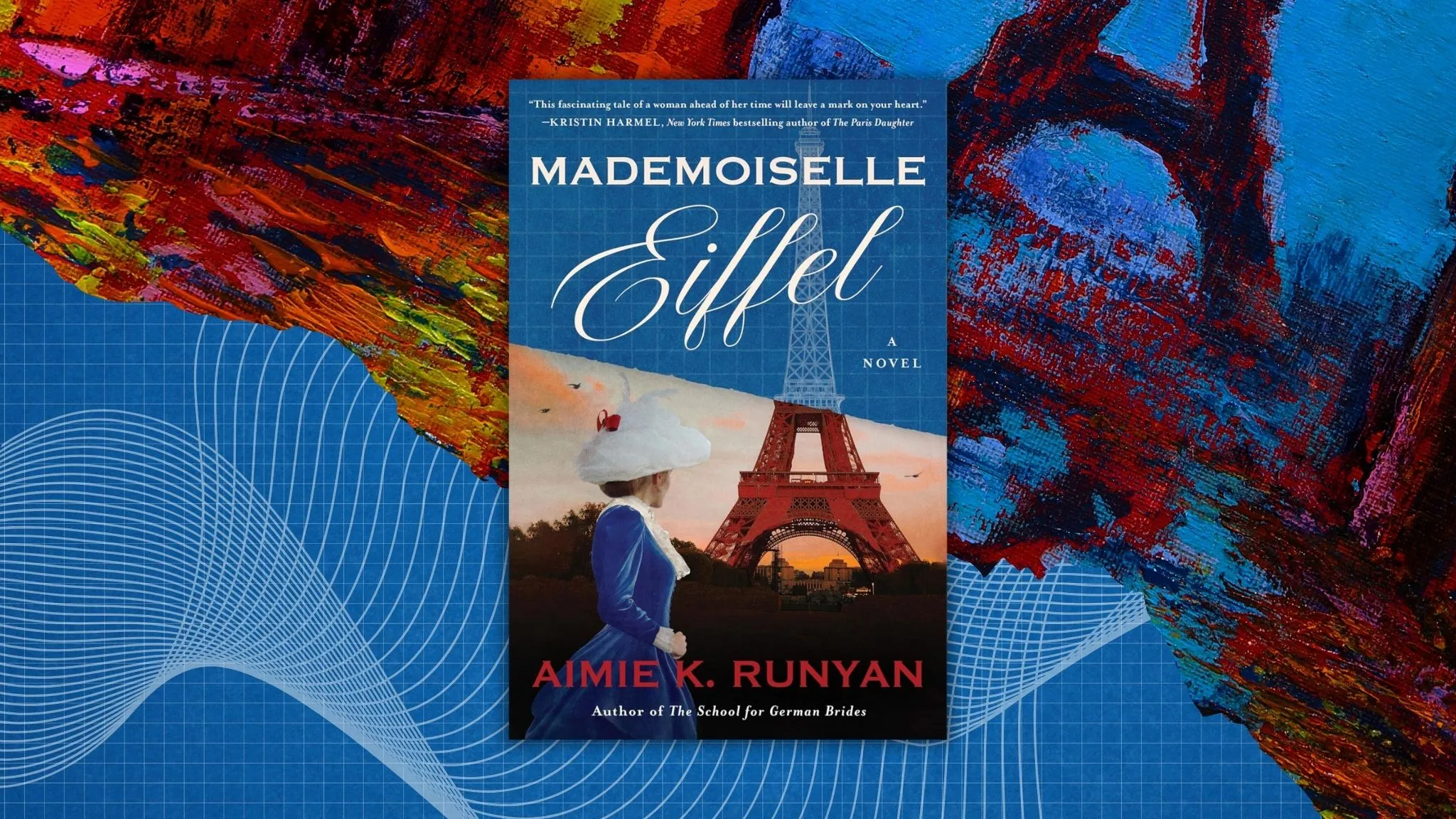Mademoiselle Eiffel by Aimie K. Runyan
The Eiffel Tower, chosen as the symbol of the 2024 Summer Olympics in Paris, is adorned with the Olympic Rings called “The Spectaculars,” in the official colors by day and lit in white at night. They were installed between the first and second floors several weeks before the opening ceremonies and remain in place despite objections from Eiffel family descendants.
The timing coincides with best-selling author Aimie K. Runyan’s latest work of historical fiction, Mademoiselle Eiffel. It’s a charming, warm and heartfelt tribute to Claire Eiffel in a colorfully envisaged accounting of her life.
In the absence of a well-documented biography and a dearth of family letters, little, if anything, is known about the feelings and thoughts of this intriguing woman. This lovely novel vividly imagines her existence. It is with significance that a richly clad Claire proudly stands alongside Gustave Eiffel and Thomas Edison depicted in life-like wax models in the architect and engineer’s restored office at the top of the tower which is open to visitors.
Claire’s Real and Imagined Life
Claire worked behind the scenes with her esteemed father for over forty years until his death in 1923 at the age of 91. Who really knows if her ambitions and desires might have differed from her comfortable existence as his primary helpmate?
She was the eldest of Gustave Eiffel’s five children and almost certainly the one closest to him. Claire was fourteen when her mother died in 1877. She immediately assumed responsibility for the household management and care of her younger siblings, two sisters and two brothers. At the same time, she took on the considerable hostess duties of the late Marie Gaudelet Eiffel.
In short order, she became her father’s personal and social secretary as well as confidante. Today she would be termed a highly trusted executive administrator and event coordinator who occasionally accompanied him on business trips.
In 1885 she married Eiffel’s protégé and partner, Civil Engineer Adolphe Salles, with whom she had three children. The Marseilles-born, strikingly handsome mining engineer and specialist in iron works was five years senior to Claire. Whether it was an arranged marriage of convenience or a love match that was facilitated by his close working relationship with Gustave is a matter of conjecture.
In order to accommodate their collaborative work on many projects, the couple resided with Gustave Eiffel in a wing of his grand, well-appointed home in a fashionable neighborhood of Paris. His other four children resided in separate homes in Paris after their marriages. Tragically, Adolphe died at age 65 just three days after his famous father-in-law. She remained in the Paris mansion until her death 11 years later.
Author Weaves History and Drama
In Mademoiselle Eiffel, Claire is depicted as a beautiful, highly intelligent young woman, well-educated, adept at drawing and passionately interested in her father’s fields of engineering and architecture.
While she likely could have chosen to study sciences at the Sorbonne which accepted female students, her father’s alma mater, the prestigious École Centrale des Arts et Manufactures (Polytechnic Institution) did not accept women. Her own goals and desires became permanently subsumed when her vibrant mother Marie suddenly died at the young age of 32.
Both the fictional and real Claire Eiffel proved to be exceptionally mature and capable. Aimie Runyan has inserted conflict in the form of initial animosity between the heroine and her future husband. There is also drama in her rescue of her wayward younger brother who was described as a gambling wastrel and mediocre scholar attending university in Paris.
Claire celebrates with the family when the construction of the centerpiece of the World’s Fair is awarded to the firm and works diligently to clear her father’s name besmirched in a worldwide Panama Canal scandal in which investors lost a great deal of money. As a contractor brought in late in the project and not one of the parties responsible for the financial difficulties, Gustave Eiffel was a scapegoat and was ultimately found innocent of charges.
Brings the Parisian Gilded Age to Life
Mademoiselle Eiffel and the early life of Claire take place during La Belle Époque, the “beautiful era” which came to an end in 1914 at the onset of WWI. It was a time of peace and prosperity coupled with cultural and industrial advancements.
Their magnificently appointed mansion had all the trappings of luxury; a full complement of servants, indoor plumbing, electric lighting and telephones. Completing this portrait of wealthy living, they additionally owned a summer home. Claire and her siblings could well afford custom-tailored clothing, gourmet foods and wines in addition to lavishly entertaining clients and guests.
Aimie Runyan liberally splashes details that effectively bring the Parisian Gilded Age to life. Mademoiselle Eiffel is a sprightly, engaging novel certain to please readers. This lovely novel imagines Claire Eiffel’s possible unfulfilled dreams and professional ambitions through a 21st-century lens.
A Work of Art — and a Business Venture
It is interesting to note that the Eiffel family name was not formally changed until 1880. Their heritage was paternally German and maternally French German. Alexandre Gustave Bönickhausen dit Eiffel was the architect and engineer’s surname at birth. The prosperous, well-educated merchant class Bönickhausen Family had moved from Germany to Paris in the early 19th century. “Dit Eiffel” refers to the place of their origins, ‘from the Eifel Mountains’.
Examples of Gustave Eiffel’s designs/constructions are found worldwide. His stated preference was to build bridges. As well as being one of the leading engineers of the era, he was an astute businessman.
The Eiffel Tower might not have been built despite its selection as the contest-winning design had he not agreed to personally finance the construction cost. The City of Paris underwrote 1.5 million francs and the Eiffel Company financed the remaining 5 million for the creation of the tallest building in the world at that time.
It proved to be a canny investment for he contractually received the revenue from visitors to the structure for the first 20 years. Some 10 million visitors flocked to marvel and ride the elevators of the Eiffel Tower in 1889, paying five francs for the privilege. He recouped his investment and earned an additional 5 million francs in the first year alone!
The Significance of the Eiffel Tower
Eiffel retired not long after the Panama Scandal and the company changed its name to La Société Constructions Levallois-Perret, with Maurice Koechlin, the actual designer of the Tower, serving as managing director. Gustave Eiffel was now free to pursue his interests in aerodynamics and meteorology from his third-level office atop the eponymously named tower.
After it opened, he installed meteorological measuring equipment, creating a meteorological lab on the tower, and invited other scientists and inventors to use it for their own experiments. Prudently he incorporated a radio antenna and wireless telegraph transmitter into the tower’s design which effectively thwarted the original plan of disassembling it after 20 years. The radio facility proved to be immensely useful, particularly during the two world wars. In 1910, Gustave Eiffel was granted a 70-year extension to his lease. The Eiffel Tower reverted to ownership of the City of Paris in 1980.
Connecting the Past and the Present
The intricate lacy ironwork of the Eiffel Tower, originally painted reddish brown, has been admired by some 300 million visitors who have flocked to visit this monument to engineering achievement.
Claire Eiffel Salles would surely have been proud to know that every 2024 Summer Olympic and Paralympic medal was adorned with a highly symbolic piece of metal: the original iron used in the construction of the Eiffel Tower. Fittingly, they were created by the famed Chaumet Jewelers who designed Claire’s wedding gift, a magnificent pearl necklace commissioned by her doting father Gustave.
 Aimie K. Runyan is a multi-published and bestselling author of historical and contemporary fiction. She has been nominated for a Rocky Mountain Fiction Writers Writer of the Year Award, a Historical Novel Society’s Editor’s Choice selection, and a four-time finalist for the Colorado Book Awards. She is an adjunct instructor for the Drexel University MFA in Creative Writing program and endeavors to be active in the literary community in Colorado and beyond. She lives in the Rocky Mountains with her wonderful husband, two (usually) adorable children, two (always) adorable cats, and a dragon.
Aimie K. Runyan is a multi-published and bestselling author of historical and contemporary fiction. She has been nominated for a Rocky Mountain Fiction Writers Writer of the Year Award, a Historical Novel Society’s Editor’s Choice selection, and a four-time finalist for the Colorado Book Awards. She is an adjunct instructor for the Drexel University MFA in Creative Writing program and endeavors to be active in the literary community in Colorado and beyond. She lives in the Rocky Mountains with her wonderful husband, two (usually) adorable children, two (always) adorable cats, and a dragon.





